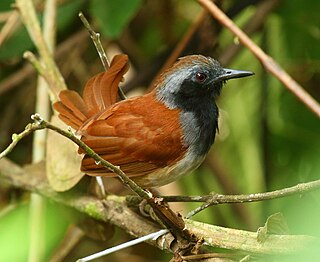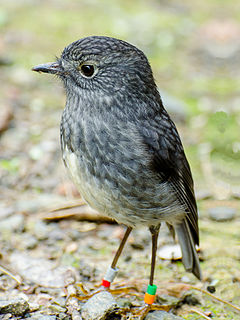
Compsognathus is a genus of small, bipedal, carnivorous theropod dinosaur. Members of its single species Compsognathus longipes could grow to around the size of a turkey. They lived about 150 million years ago, during the Tithonian age of the late Jurassic period, in what is now Europe. Paleontologists have found two well-preserved fossils, one in Germany in the 1850s and the second in France more than a century later. Today, C. longipes is the only recognized species, although the larger specimen discovered in France in the 1970s was once thought to belong to a separate species and named C. corallestris.

The bushwren, bush wren, or mātuhituhi in Maori, was a very small and almost flightless bird that was endemic to New Zealand.

The white-bellied antbird, is a passerine bird which breeds in the tropical New World from Panama to northern Brazil and in Trinidad. It is also called Swainson's antcatcher after William John Swainson, who first described it scientifically. The genus is monotypic.

Discoplax longipes is a species of terrestrial crab. It is found in karstic caves on Pacific islands and ranges from the Loyalty Islands to French Polynesia. Mating occurs in the caves, after which the females migrate to the sea to release their fertilised eggs. The genus Discoplax was for a long time synonymised with Cardisoma, but was resurrected in the late 20th century.
Long-footed potoroo – Potorous longipes – is a small marsupial found in southeastern Australia, restricted to an area around the coastal border between New South Wales and Victoria. It was discovered in 1967 when an adult male was caught in a dog trap in the forest southwest of Bonang, Victoria. It is classified as endangered.

The Kashmir cave bat is a species of vesper bat. It is endemic to the Western Himalayas of South Asia.
The big-eared swamp rat is a species of rodent in the family Muridae. It is found in Angola, Cameroon, Central African Republic, Republic of the Congo, Democratic Republic of the Congo, Equatorial Guinea, Gabon, Nigeria, Uganda, and Zambia. Its natural habitat is subtropical or tropical moist lowland forests.

The long-footed treeshrew is a treeshrew species within the Tupaiidae. It is endemic to Borneo and threatened due to deforestation and degradation of habitat.

The Savanna swamp shrew is a species of mammal in the family Soricidae. It is endemic to Nigeria. Its natural habitat is swamps. It is threatened by habitat loss.

The North Island robin is a species of Australasian robin endemic to the North Island of New Zealand. It and the South Island robin of the South Island and Stewart Island were once considered conspecific, but mitochondrial DNA sequences have shown that the two lineages split prior to the Pleistocene and support the classification as two different species.
Erythrochampsa is an extinct genus of protosuchian crocodylomorph. Fossils have been found from the Red Beds of the Stormberg Group, the youngest group of strata from the Karoo Supergroup outcropping in South Africa.

Libo County is a county of Guizhou, China. It is under the administration of the Qiannan Buyei and Miao Autonomous Prefecture.

Stellaria longipes is a species of flowering plant in the pink family known by the common names longstalk starwort and Goldie's starwort. It has a circumpolar distribution, occurring throughout the northernmost latitudes of the Northern Hemisphere. It grows in a wide variety of habitat types, including tundra and taiga and many areas farther south with subalpine and alpine climates. It is extremely variable in morphology, its form depending on both genetic makeup and environmental conditions. It has a widely varying number of chromosomes. In general, it is a rhizomatous perennial herb forming mats or clumps, or growing erect. The stems may be short and simple or with sprawling and highly branched. The linear to lance-shaped leaves are usually 1 to 4 centimeters long and are oppositely arranged in pairs. The inflorescence bears one or more flowers, each on a short pedicel. The flower has five pointed green sepals each a few millimeters long. There are five white petals each divided into two lobes, sometimes shallowly, but often so deeply there appear to be two petals. The plant is gynodioecious, with some flowers having functional male and female reproductive parts and others being only female.
Anthracodromeus is an extinct genus of Late Carboniferous protorothyridid known from Ohio. It is known from the holotype AMNH 6940, a nearly complete skeleton. It was collected in the Linton site in Jefferson County, from the upper Freeport Coal Member. A. longipes was first assigned by Edward Drinker Cope in 1875 to a species of Sauropleura. The genus was first named by Robert L. Carroll and Donald Baird in 1972 and the type species is Anthracodromeus longipes.

The comet darner is a common species of dragonfly of the family Aeshnidae.

Sybra is a genus of beetles in the family Cerambycidae, containing the following species:

Sybra umbratica is a species of beetle in the family Cerambycidae. It was described by Pascoe in 1865.

Sybra ordinata is a species of beetle in the family Cerambycidae. It was described by Bates in 1873.
Sybra pascoei is a species of beetle in the family Cerambycidae. It was described by Lameere in 1893.

Panulirus longipes, the longlegged spiny lobster, is a species of spiny lobster that lives on shallow rocky and coral reefs in the tropical Indo-Pacific region. The International Union for Conservation of Nature has assessed its conservation status as being of "least concern".















